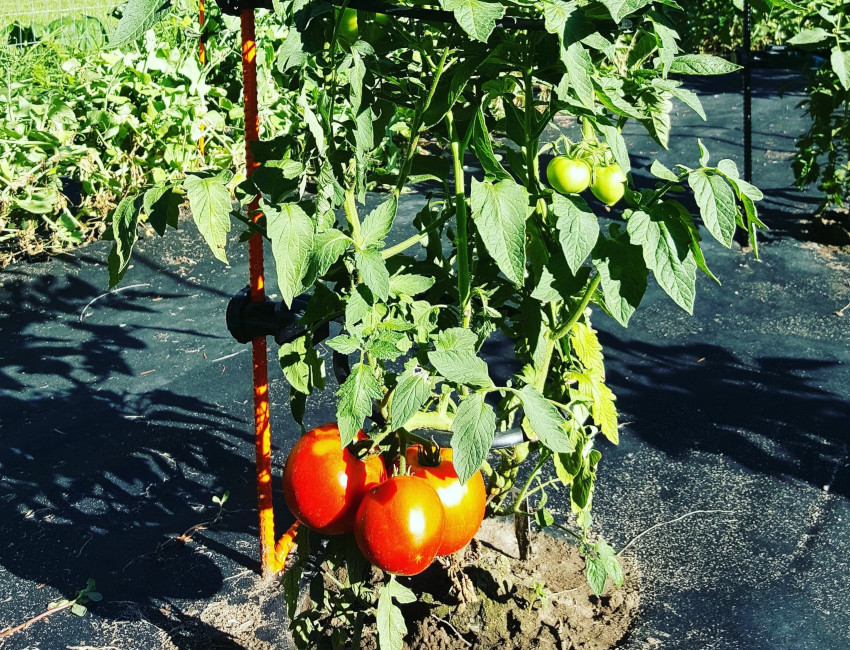It’s a good sign when plants get tall because it means they are thriving. However, rain, wind, or plants’ weight may cause some to lean or bend as they grow. Adding support can keep plants upright and help them continue to stay healthy.
Some plants are prone to leaning, but it’s essential to know when and how to use support. There are various ways to keep indoor and outdoor plants upright.
Gardeners can use traditional methods, such as stakes or cages, but many now opt for durable, easy-to-use plant support rings.
Why Some Plants Need Support
Plants may need support because they have fragile stems that can easily break. Per the National Institutes of Health, climbing plants must grow vertically to get all the sun they need to stay healthy, and a trellis or stakes help keep plants upright.
It’s a common problem with vegetables like tomatoes. Some plants get too tall for their health, and some are not strong enough to resist the elements. Plants may bend because they grow heavy flowerheads or fruit that is too heavy for their stem.
Plants That Commonly Need to Be Supported
While adding support can benefit any plant that begins to grow out of control, several types need the extra help to stay healthy.
Vegetables
Nearly all vegetables need some support as they grow. Traditional gardeners who grow tomatoes typically stake plants every growing season or rely on growing cages to keep plants upright. Cages can be used on other vegetables, too. Some growers are now using plant rings instead.
Flowering Perennials
Perennials such as delphiniums, zinnias, dahlias, sweet peas, sedums, lilies, and peonies can live two years or longer but usually need support during the growing season.
Top-Heavy Houseplants
House plants such as pothos, philodendron, and young fiddle leaf fig trees need support that helps guide their growth. Many would lean against trees in their natural habitats. Gardeners often use bamboo poles as support stakes that simulate plants’ native environment and help keep them healthy and strong.
Young Trees
Support can also benefit saplings, especially those growing in heavy rain and wind areas. Growers usually attach either a single stake to each tree or place one stake on either side of the tree. Plant support rings also work very well.
When to Use Stakes to Keep Plants Upright
Staking plants involves driving stakes into the soil near plants and securing stakes to plants with ties, tape, or other means. Expert gardeners often stake plants when they are young and are still trying to find support.
Some growers add stakes to pots during the planting process. This method helps prevent root damage caused by driving support stakes into the ground near mature plants.
According to Berea College, staking gives plants the ability to grow without bending to a point where they break and growth stops. Stakes can also stop fruit from rotting if it sits on the ground due to a bent stalk
You can use support to keep plants upright at any time in their lives, but healthy plants often need extra help during the growing season. Staking is a good idea whenever a plant looks floppy or gets too tall.
You may want to add support simply to make your plants more attractive. When you keep plants upright, they become healthier and more decorative.
How to Keep Tall Plants from Falling Over
It is crucial to look for signs that plants are in danger of falling over. If branches are starting to sag, foliage or blooms are drooping, or plants are becoming top-heavy, they could be in trouble.
Pressing a simple stake into the soil and then tying the stake to a plant may be enough help for plants with main stems. Wire cages are the best choice for thin-stemmed plants with thicker foliage or vegetables like tomatoes.
Some growers wrap wire around plants to support them, but gardeners using this method must be careful not to harm plants. A wire is sharp and can also cut gardeners’ hands.
Plant support rings are a safe and effective way to keep plants upright. They offer gentle support and are easily adjusted as the plant grows.
How to Stake Indoor Plants for Support
Houseplants often need support when they begin to reach toward light, weakening their stalks. Sometimes pruning can take care of the problem, but if it isn’t, stakes can help.
It’s essential to choose the correct type of support for your needs. While single stakes work well for many plants, cages and rings offer more support and are ideal for mature plants.
Insert stakes into soil carefully to avoid harming root systems. Also, consider aesthetics. You may want to use stakes made of bamboo materials, which blend in. Ensure stakes are shorter than top branches, so they can’t be seen.
The Benefits of Plant Rings
Any support that will keep plants upright is better than allowing plants to lean or bend. However, options like stakes, cages, and trellises can be time-consuming to maintain. Gardeners also have to be careful not to harm plants in the process.
Many growers now opt for alternatives such as EZ Step plant rings. Ring systems include a step-in post that can easily be put into the ground using foot pressure.
The three-part ring system has a D-Lock design that holds the ring in place and ensures plants stand straight in all conditions. Every package contains an EZ ring as well as an arm and nut that attach to the step-in post.
Choosing the Best Plant Rings
Plant support rings can be made of plastic, natural materials, or metal. They usually look somewhat like steering wheels, and there are various styles. Some rings have a central claw-like clip through which gardeners push a bamboo pole. The rings keep plants upright at nearly any height.
There are also plant support rings that require three canes tied around the rings’ edge. Rings are often added early in the season so that stems grow up through the ring and hide it.
E-Z Step plant rings are available in various sizes to suit customers’ needs. They are made of steel, coated to protect plants, and sold in two colors. They can be added at any stage of growth and, it is easy for growers to add rings to accommodate plants’ changing needs.
Unlike many plant support methods, E-Z Step rings are made to last for years, so they are also an affordable choice.
Choosing the Best Stakes
Most garden stakes are made of metal, natural materials, or plastic. The right type for you depends on how you plan to use it.
Metal stakes are the sturdiest and typically cost the most. Plastic is durable but not sturdy enough for heavy plants. Natural materials such as bamboo are beautiful but can rot and need to be replaced.
It’s essential to gauge the thickness you need. The heavier the plants, the thicker the stake you will need.
The design also matters. Choose a type of stake that appeals to you and gets the job done.


